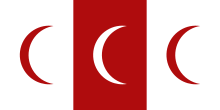This article or section is in a state of significant expansion or restructuring. You are welcome to assist in its construction by editing it as well. If this article or section has not been edited in several days, please remove this template. If you are the editor who added this template and you are actively editing, please be sure to replace this template with {{in use}} during the active editing session. Click on the link for template parameters to use.
This article was last edited by [[User:|]] ([[User talk:|talk]] | contribs) 0 seconds ago. (Update timer) |
| بنو كرنلي Karanle | |
|---|---|
| Hawiye Somali clan | |
 Flag of the Adal Sultanate used by Ahmad ibn Ibrahim al-Ghazi | |
| Ethnicity | Somali |
| Location | |
| Descended from | ٍSheikh Ahmed Bin Abdulrahman Bin Uthman |
| Parent tribe | Hawiye |
| Branches |
|
| Language | |
| Religion | Sunni Islam |
 |
| Part of a series on |
| Somali clans |
|---|
The Karanle (Arabic: كرنلي ,كرن, Somali: Karanle, Karan) are a Somali clan, forming one of the six branches of the larger Hawiye clan.[1] The Karanle are geographically spread out across three countries: Somalia, Ethiopia, and Kenya. Among all of the Karanle inhabited regions of the Horn of Africa, Ethiopia is the where the majority of the clan reside. In Ethiopia, the Karanle are mainly found in Harar, Hubat, and Babile but they also inhabit the Somali Region, Dire Dawa and surrounding regions.[2] The majority of the Karanle Sub-clans predominantly reside in the regions of Ethiopia where the Somali population is predominant, with the exception of the Murusade Sub-clan, who reside in central and southern Somalia.
Karanle, was the firstborn son of Sheikh Ahmed (Hawiye),[3] and was born to his first wife Arbera, who is said to be of Yemeni descent, and thus was tasked with the duty of upholding harmony within the community. The Karanle have been notably involved in the facilitation of peaceful resolutions through mediation. According to historical accounts, they are recognised as the maternal forebears of several prominent clans, such as the Hiraab, the Bimal, and other subclans of the Ogaden clan.[4][5][6]For their age in antiquity and positive relations with many clans, the Garads and Ugases of Karanle have often participated in coronations of new traditional leadership in many parts of the countries.
The Karanle are credited for fighting foreign invaders in Somalia and Ethiopia where they historically shared a long border.[7][8][9][10] Karanle's tomb can be found in Qundhuro, situated within the Haraghe region alongside his father, Shiekh Ahmed Hawiye's tomb.[11]
The Karanle of Somalia and Ethiopia are also closely linked with several ancient historical capitals such as Harrar and Mogadishu, setting up foundational quarters of the towns such as Harar's Erer Gate of the Reer Erer Nur of the Gidir clan family which houses the tomb of Nur Mujahid and the Jami Mosque, the oldest in town. Similar infrastructure include the Gidir Magala marketplace of Harrar and the Murursade Gate of South Mogadishu.[12] The Sheikh Basikh (or Raoûf) Mosque, once the largest in town, was a political centre for Karanle figures before its conversion to the Medhane Alem church in 1890 at the hands of Menelik after the Battle of Chelenqo.
- ^ Sensenig, Peter (2 March 2016). Peace Clan: Mennonite Peacemaking in Somalia. Wipf and Stock Publishers. p. 173. ISBN 9781498231015.
- ^ The universal geography : earth and its inhabitants (PDF).
- ^ Sensenig, Peter (2 March 2016). Peace Clan: Mennonite Peacemaking in Somalia. Wipf and Stock Publishers. p. 55. ISBN 9781498231015.
- ^ Lewis, I. M. (January 1960). "Somalia. Scritti vari editi ed inediti. II. Diritto. Etnografia. Linguistica. Come viveva una tribù Hawiyya. By Enrico Cerulli. A cura dell'Amministrazione Fiduciaria Italiana della Somalia. Rome, 1959. Pp. 392, ill". Africa. 30 (1): 92–93. doi:10.2307/1157752. ISSN 0001-9720. JSTOR 1157752.
- ^ Ullendorff, Edward (February 1960). "Enrico Cerulli: Somalia: scritti vari editi ed inediti, II. Diritto, etnografia; Linguistica; Come viveva una tribù Hamiyya. (A cura dell'Amministrazione Fiduciaria Italiana della Somalia.) [v], 392 pp., col. front., 36 plates. Roma: Istituto Poligrafico dello Stato, 1959". Bulletin of the School of Oriental and African Studies. 23 (1): 191. doi:10.1017/s0041977x00149468. ISSN 0041-977X.
- ^ Abbink, J. (1999). The Total Somali Clan Genealogy: A Preliminary Sketch. African Studies Centre.
- ^ Italiana, Società Geografica (1893). Atti del primo congresso geographico italiano tenuto in Genova. p. 362.
- ^ L'ultimo impero cristiano politica e religione nell'Etiopia contemporanea (1916- 1974)|quote="The Hawiye chiefs who together with their sons, participated in the plans of Lij Jasu only aggravated the violence on both sides. The Hawiyas, in revenge, destroyed the crops around Harar in order to create a scorched earth policy and raided numerous cattle, which were partly owned by Aqa Gabru. The punitive expedition led by the Amhara faced an entire coalition made up of Geri Somali and Ogaden soldiers, but led by the Hawiya."
- ^ Moizo, Bernard (1999). Variations. L'Aube. p. 33.
- ^ Roma, La Somalia Italiana e l'eccidio di Lafole, (Rivista Marittima: 1897)
- ^ "Etymology and genesis of the Hawiye". 26 June 2024.
- ^ Guides, Rough (2018). The Rough Guide to Ethiopia. Apa Publications. p. 136.
© MMXXIII Rich X Search. We shall prevail. All rights reserved. Rich X Search
